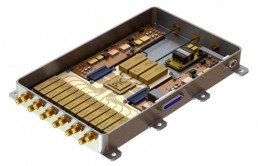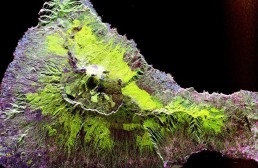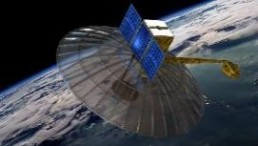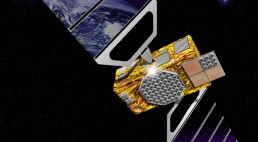In close collaboration with universities, research institutes and space agencies, Antwerp Space conducts innovative research in cutting-edge technology, making use of state-of-the art equipment, algorithms and techniques.
Moreover, Antwerp Space takes part in all major international space conferences and publishes papers regarding its technical achievements. A small selection of the currently ongoing innovation projects is presented below.

Microwave Photonics Technology for Telecom Payload
The Photonics Integrated Circuit (PIC) is an emerging branch of photonics in which optical passive and active devices are fabricated as an integrated structure upon the surface of a flat substrate. As a result of integration, complex photonic circuits can now process and transmit light in similar ways as electronic integrated circuits process and transmit electronic signals. The stringent requirements of use in space on the one hand and huge demand for high performance, low cost modules on the other hand push the space technologies and research activities toward more compact and integrated solutions. This is the convergence point between PIC technology capabilities and space market needs. Microwave photonics is a promising technology to overcome the traditional RF technology limitation by providing much wider bandwidth (up to 100 GHz), smaller volume, lower mass and power consumption. Our research and product portfolio includes frequency conversion and frequency generation for the High Throughput Satcom applications.

Laser communication for satellite constellation
Satellite connectivity over constellations requests very high data rates to be transmitted between the satellites and between the satellites and ground feeder stations. The limitation of the classical RF frequency transmitters and the limited availability of ITU regulated frequencies, as well as the conflict with the 5G community in the Ka/Q-Band, is pushing the use of Laser Communication for these constellations. The resilience against intentionally disturbance or wiretapping of the laser communication technology is an additional asset for the market players and their customers. Antwerp Space is collaborating with PIC foundries and packaging partners in one side and the Laser Terminal providers on the other side to bridge the gap between them for this laser communication application and accelerate its development speed.

Synthetic Aperture Radar electronics
Antwerp Space is developing efficient and cost effective satellite radar payloads. Satellite radars produce a large range of remote sensing data useful to assist in surveillance missions, to detect possible threats and prevent crises, to improve asset management and to support deployed forces. Rapid delivery and analysis of the collected information, supports, when needed, immediate decision-making.
Antwerp Space provides customers advice about the appropriate type of radar for the application and delivers dedicated radar solutions to Earth and Atmospheric observation missions.
In a recent study, Antwerp Space established the feasibility of integrating a compact and affordable X-band SAR (Synthetic Aperture Radar) into a 100 kg satellite while offering meter-range resolution and an operational duty cycle in excess of 5 minutes per orbit. This unique usage efficiency enables operators to reduce their capex and service providers to sell competitive imaging and analytical products.
This advanced generation of SAR designed by Antwerp Space is based on a photonic beamforming technology.
This type of Radar is designed for maritime and land monitoring such as the detection of ships or to identify urban deformation. It can also be used for emergency management, e.g. through flood monitoring.

Beamforming Technology for Radar front-end
High-resolution, wide-swath radars based on Scan-on-Receive (SCORE) technology are emerging as practical and flexible radars for Earth observation. The core of this technology is a Beam Forming Network (BFN) where each channel of the network is simultaneously controlled in phase and amplitude. Current technologies behind this BFN are either RF-network based or use digital beamforming. Our optical beamforming network technology (OBFN) provides a more compact, lower power and broadband solution for the SCORE integration in a Compact SAR (Synthetic Aperture Radar). A H2020 project is running to develop this OBFN technology in collaboration with a European-based PIC consortium.

Next generation PRS capable GNSS receiver
Antwerp Space is developing GNSS (Global Navigation Satellite System) receivers supporting the Public Regulated Service (PRS), which is an encrypted navigation service of the European Galileo satellite navigation system for authorised users. Antwerp Space is leading technological innovations in Belgium for the development of operational PRS receivers for field applications. The focus of these activities is on the optimization of PRS receiver and security module architectures in order to make optimal use of the security features of the PRS signals, and to achieve compliance to the stringent EU security requirements for security accreditation. The Secure GNSS receivers by Antwerp Space will protect against GNSS signal attacks and provide robust and secure positioning, navigation and timing to a range of European governmental applications such as police, fire brigades, ambulances, critical national infrastructure, peace-keeping forces and defence.